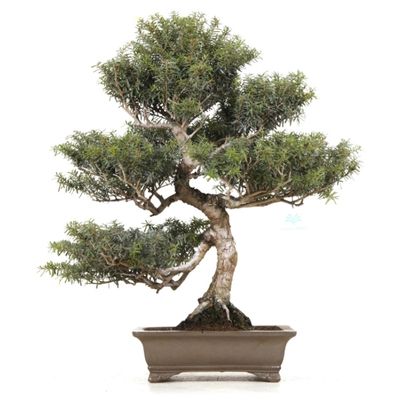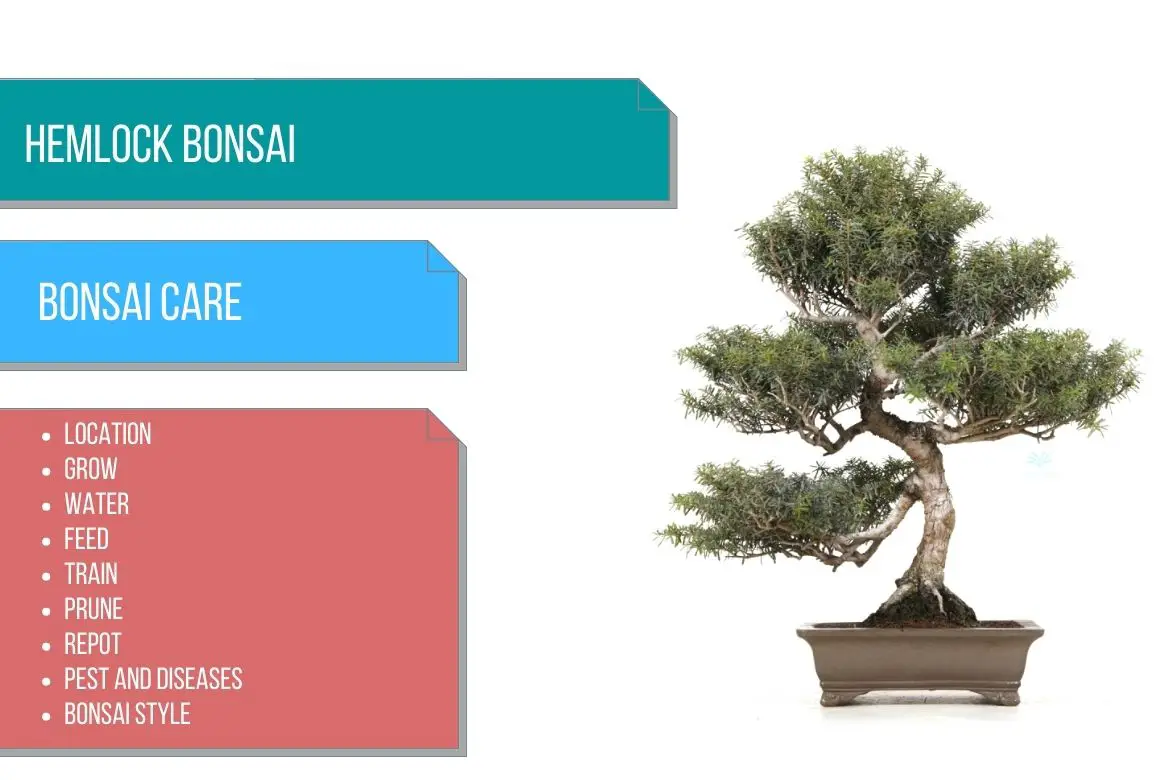
Hemlock
(Tsuga)
Country of Origin : Japan, China and North America
Bonsai Styles : All bonsai styles except broom style
Zone : 2 – 4
Hemlock also known as Tsuga is a hardy conifer and makes a beautiful and handsome bonsai tree.
A tall, elegant hemlock tree has pyramidal branches that droop gracefully downward to resemble a waterfall.
Wild populations of this evergreen conifer grow in Japan, China, and North America.
In addition to their upright, conical growth habit and their small, dark green leaves (light green when growing in new shoots), hemlocks have a more refined leaf structure than Taxus (Japanese yew and Chinese yew).
Tsuga has a purple-brown bark with long narrow cracks. The bark also flakes in a very appealing pattern.
Depending on the location of origin, there are amy types of hemlock bonsai trees:
- Tsuga canadensis – Also known as Eastern Hemlock or Canadian hemlock. It is one of the most commonly available hemlock species to make a bonsai.
- Tsuga heterophylla – Also known as Western hemlock. It is commonly found in the western cost of North America.
- Tsuga diversifolia – Also known as ‘kometsuga‘ or Northern Japanese Hemlock. This is also one of the most commonly used hemlock species to make a bonsai specimen.
- Tsuga sieboldii – Also known as Southern Japanese hemlock. This hemlock bonsai species is not very common.
Best location to keep Hemlock Bonsai
It is fine to keep the hemlock bonsai tree in full sun during summer, but they will appreciate some shade from direct sunlight of harsh summers.
A good idea will be to keep the bonsai tree in partial shade at all times.
It is a hardy plant that does not require special protection in winter. However, if prolonged periods of freezing temperatures are expected, shift the bonsai pot in a frost-free shed or a greenhouse.
Also, protect the bonsai from freezing winds. As these winds will dry out the foliage.
You can also spray the foliage in hot weather.
Refer sunlight requirements for indoor plants for more indoor gardening ideas. Also, refer to do bonsai trees need sunlight for more indoor and outdoor bonsai location ideas.
Propagation of Hemlock
Hemlock tree can be propagated by using softwood cuttings in fall and summer.
It can also be propagated by sowing seeds in early spring or winter.
Watering Hemlock Bonsai
It is imperative to water your hemlock bonsai tree regularly throughout the growing season, giving them more water in the summer.
Reduce the frequency of watering in winter. Keep the soil moist but not waterlogged. Do not let the bonsai soil dry-out.
The hemlock trees love slightly acidic water.
Read watering bonsai tree for more details about immersion technique.

When watering a hemlock bonsai tree that hasn’t been repotted for a while, make sure that you thoroughly soak the rootball.
Sometimes, the roots can be far down in the trunk. Hence making sure that enough water has reached the roots is always a good idea.
You can also check how far are the roots by scrapping some soil from one side and digging a little to find the root system.
Wiring Hemlock Bonsai
Branches can be shaped by Wiring can be minimized with small-needled varieties by trimming new shoots regularly and pruning them back to the old wood. There are even some bonsai enthusiasts who don’t wire at all.alone, so little wiring is necessary.
However, in case you decide to wire the bonsai, it is advisable to wire the hemlock bonsai tree between early autumn and early spring, but avoid wiring soft, non-lignified branches.
Due to the slender nature of the twigs, wiring needs to be delicate and precise.
Make sure that you have not trapped any foliage under the wire. Guy wire is a good choice.
Tip: Use copper wire for bonsai trees which are meant for exhibitions.
It is possible to leave the wire on for two or three years. However, keep checking the wires to make sure that it is not biting into the bark.
Pruning Hemlock Bonsai
When to prune hemlock bonsai?
How to prune Hemlock bonsai?
Hemlock trees are slow growers. The branches will take time to thicken.
Spring or autumn are good times to prune hemlock bonsai trees.
Branches should be cut back above a tuft of needles. Make sure not to cut through the needles.
Aggressively prune the branches once the branches have hardened so that you can control the vertical growth of the tree.
Prune in a way that the interior of the tree receives adequate amount of light and air.

Hemlock trees prefer growing vertically more (instead of spreading), hence prune accordingly to keep the vertical growth in check. By this you will be able to achieve good branching.
Pinching Hemlock Bonsai
Pinching can be done throughout the growing season to maintain the bonsai style.
In the growing season, finger pinch young shoots before they harden, leaving only a few needles.
Repotting Hemlock Bonsai
When to repot Hemlock bonsai?
Hemlock bonsai tree can be repotted every 2 years in spring in case of young trees.
However, for older trees (10 years of so), repotting can be done every 3-5 years.
Also, while repotting, prune the roots. Do not prune more than 1/3 of the root system.
Hemlocks prefer acidic soil (5.5-6.5 pH). Mix soil acidifier in the soil.
You can use a free-draining, acidic bonsai soil mix.
OR
You can also make a soil mix loam, sharp sand and peat (or compost) in the ration of 1:1:1.
Must Read: Bonsai Soil Recipes
Must read : Choosing the right bonsai container
Feeding Hemlock Bonsai
In the spring, fertilize the soil with a high-nitrogen fertilizer.
After that, switch to a low-nitrogen feed and apply it once a month until the summer is over.
Do not feed the hemlock bonsai tree during winter.
As stated earlier, use a soil adicifier because these trees prefer slightly acidic soil.
Read more about bonsai fertilizer and its application.
Diseases and pest of Hemlock Bonsai
Hemlock trees are usually trouble-free. However, in some occasions, scaled insects can pose some problems. Use a systemic insecticide or remove them manually.
In rare cases, hemlock bonsai can be infected with woolly adelgid or swiss needle cast.
Woolly adelgid look like cotton balls appearing below the shoots bearing the needles. Apply an insecticide containing imidacloprid or dinotefuran.
In swiss needle cast, the foligae will stast loosing its green color and the needles will be covered in reddish-brown spots. For swiss needle cast apply a fungicide containing chlorothalonil or mancozeb
What to look for when buying Hemlock Bonsai
Before making a purchase, check the bark for any signs of any pruning wound which was not sealed properly.
Since most of the times, hemlock trees produce roots far down in the soil from its trunk, checking the root system is going to be not that easy. However, do not worry. You can always get the tree back to a healthy root system as these trees tolerate heavy root pruning pretty well.
Preferably, opt for a bonsai specimen which has got a good spread. (As these trees prefer growing vertically more). You will save some time in achieving your desired bonsai style by doing this.

